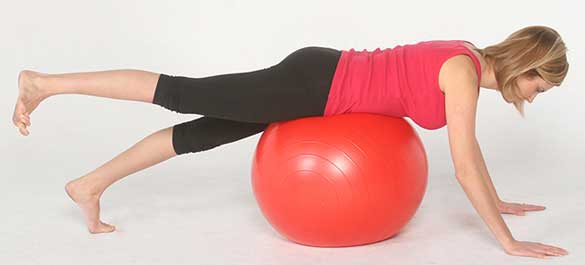
People often turn to health and fitness professionals for help in addressing muscle and joint pain. Therefore, being able to create programs that are focused on pain relief and corrective exercise techniques is an effective way for trainers to expand their offerings and provide clients with the guidance they need to be able to participate in their favorite sports and activities.
This is the final installment of a three-part series addressing chronic muscle and joint pain. While part 1 focused on how to how to design effective self-myofascial release (SMR) programs, part 2 addressed how to progress programs to include the integration of stretching techniques. This third and final installment describes how to further advance your pain-relief program-design skills by assimilating corrective strengthening techniques into your clients’ programs.
When to Use Corrective Strengthening Exercises in Client Exercise Programs
Exercise programs designed to alleviate muscle and joint pain should begin with the introduction of SMR techniques, progress gradually with the integration of stretching strategies and eventually incorporate a variety of corrective strengthening exercises (American Council on Exercise, 2014). Once you have assisted your clients in addressing any major myofascial restrictions they might have with appropriate SMR techniques and effective stretching exercises, corrective strengthening exercises can be introduced to develop soft tissues that have become weak or deconditioned due to pain and/or injury. This approach provides a safe and controlled environment to introduce movements to retrain a client’s neuromuscular system. Additionally, these types of exercises prepare clients to perform the complex movement patterns necessary for engaging in both daily activities and athletic endeavors.
The Benefits of Corrective Strengthening Exercises
Corrective strengthening exercises have many documented benefits, including:
- Stimulation of the formation of new brain cells and neural pathways
- Increased strength, stamina and flexibility of muscles, tendons and ligaments
- Improved posture and decreased joint pain
- Improved balance and stability
- Increased functional capacity and metabolism
- Increased bone density
- Enhanced injury prevention
- Improved digestion and reduced risk of inflammatory bowel problems
- Increased self-confidence and self-image
- Improved sense of well-being and happiness
(Price, 2013; Kim and Park, 2006; Kemmler et al., 2004, Peters et al., 2001; Ornish, 1996; Kisner and Colby, 1990)
Types of Strengthening Exercises
Many kinds of strengthening exercises can be used in a corrective exercise program. The most popular and widely used techniques are:
- Isometric
- Single joint
- Concentric
- Eccentric
- Multijoint
- Kinetic chain
Isometric
The easiest type of movement for the neuromuscular system to coordinate is an isometric muscle contraction (see Duck Stand in the sample workout below). An isometric contraction occurs when a muscle (or group of muscles) becomes activated and stays contracted to maintain a state of activation. When a client has experienced muscle and/or joint pain for some time, many of his or her muscles may not activate correctly (or may have shut down as a result of chronic misalignment). Performing an isometric contraction of muscles that have become dysfunctional helps retrain those muscles to activate correctly again before the introduction of more dynamic strengthening exercises.
Single Joint
Once a client is proficient at activating a muscle on demand, add concentric (shortening) and eccentric (lengthening) motion to that muscle or movement. (Detailed explanations of concentric and eccentric muscle actions are provided below.) When first integrating muscle motion, try to isolate muscles to a single joint action whenever possible. For example, try flexing only the big toe, as demonstrated in the Big Toe Pushdown exercise in the sample workout below. This will help avoid overloading your client’s nervous system. It can also prevent regression of the client’s program by inadvertently reinforcing old or dysfunctional movement patterns.
Concentric and Eccentric
A concentric muscle action results in the movement of a joint by shortening a muscle to bring the origin and insertion points of that muscle closer together (e.g., to bend your elbow you bring your forearm closer to your shoulder, which produces a concentric contraction in the biceps). An eccentric muscle action involves the lengthening of a muscle, which serves to slow down parts of the body as they move (e.g., your biceps lengthens as your elbow straightens when lowering a heavy box from shoulder to waist height). A concentric action produces joint movement, whereas an eccentric action slows forces to a joint(s) during movement. Concentric movements are generally safer for clients with pain/dysfunction to perform initially because there is less risk of injuring or irritating a joint if the client is unable to correctly slow eccentric movement.
Multijoint
When a client has mastered a single-joint concentric-muscle movement, integrate that muscle into a multijoint movement that involves both concentric and eccentric action [e.g., when a client can successfully perform the Duck Stand exercise, progress to the Lying Leg Lift exercise, which involves both extension of the hip and spine (both exercises are described in the sample workout below)].
Kinetic Chain
Once a client can control a muscle or group of muscles both concentrically and eccentrically, and all of the joints those muscles cross, teach him or her how to use those muscle(s) in conjunction with others as part of a sequence or kinetic chain. Here’s an example: The gluteal complex, which includes the gluteus medius, minimus and maximus, controls hip, pelvis, spine, leg and foot function due to the varied origins and insertions of each of these muscles. When working together as a kinetic chain, these muscles slow forces to the legs, knees, hips and spine by transferring the weight of the body and regulating gravity and ground-reaction forces across these body segments at the right speed and rate. A kinetic chainstrengthening exercise that requires coordinated use of many muscles to control movement throughout the body, such as the Lunge With Knee Pull in the sample workout below, is the ultimate progression of corrective exercise programming (Price, 2010).
Developing a Corrective Strengthening Exercise Program
Which muscles need strengthening?
As explained in the first two articles in this series, it is imperative that you perform a series of posture and structural assessments to identify musculoskeletal imbalances as part of your initial screening process (American Council on Exercise, 2014). The results of these assessments can direct which corrective strengthening exercises are necessary to retrain soft tissues that have been adversely affected by identified imbalances (Kendall et al., 2005). For example, one of the most common musculoskeletal imbalances that results in muscle and joint pain is overpronation (a collapsing of the foot and ankle toward the midline). This imbalance is usually accompanied by fallen arches and a weakness of the muscle that helps push the big toe down (i.e., flexor hallucus longus) (Gray, 1995). If you discover that a client overpronates, you can determine that a corrective strengthening exercise such as the Big Toe Pushdown would be appropriate for that client.
How should I teach strengthening exercises?
Here are some important considerations to ensure the successful implementation of corrective strengthening exercises into client programs:
- Supervising clients closely as they attempt any type of new movement is essential to ensure they do not get injured. However, allowing clients to make small movement mistakes as they learn a new exercise can also be beneficial. By making slight errors and then correcting each movement, clients can reprogram their nervous systems to learn how to perform the movement unconsciously on their own correctly when required.
- Everyone learns differently, so familiarize yourself with each client’s learning style. Some clients learn best by watching you demonstrate an exercise first, while others may need verbal explanations of an exercise so they can process the information before attempting the movement. Still others need to try an exercise as you explain it to see how it “feels” to do it correctly.
- Link each recommended strengthening exercise to the SMR and stretching exercises that helped prepare your client initially. Doing so not only helps your client see how they have progressed, but also provides solutions for them if they are having difficulties with a strengthening technique and need to regress back to a prior exercise.
Progressions
- Progress a strengthening exercise if a client has achieved a suitable level of competency and can perform the movement satisfactorily.
- Progress or combine isolated strengthening exercises to a kinetic chainstrengthening exercise if a client indicates that his or her corrective exercise homework is taking too much time and/or affecting his or her adherence to the program. Be certain your client is ready to advance and will not get hurt when progressing.
- Progress a corrective strengthening exercise to a specific sport or functional exercise if a client’s pain-relief goals have been met.
Regressions
- Always regress a strengthening exercise if a client experiences any type of pain or difficulty. Strengthening exercises can be regressed by allowing clients to use balance aids to assist with movements, by decreasing weights or by performing standing movements while lying on the ground. They can also be regressed to a suitable SMR or stretching exercise.
- Regress a strengthening exercise if a client reports excessive soreness in the day or two following performance of the exercise. Corrective exercises are designed to slowly retrain the way the body moves, not to overtax the muscles, neuromuscular system, joints or connective tissues. If clients have excessive muscle soreness or joint pain following a corrective exercise session, they may create additional musculoskeletal imbalances as they try to avoid the soreness.
Precautions
- If you observe a client’s technique start to deteriorate during an exercise due to fatigue, do not advise them to continue performing additional repetitions and/or sets, as this may lead to injury.
- Performing eccentric strengthening movements is an essential aspect of corrective exercise retraining. However, these types of movements can tire the body easily and potentially put joints at risk for injury. Be conservative with the volume of eccentric work you recommend for your clients’ corrective exercise programs.
Sample Strengthening Program
As mentioned earlier, a common postural deviation that causes both muscle and joint pain is overpronation (i.e., a collapsed foot and ankle). (Note: Refer to the “Foot and Ankle” assessment outlined in Using Postural Assessments to Eliminate Pain, if necessary.) Strengthening the major muscle groups affected by this imbalance will not only help alleviate pain in the feet and ankles, but can also help realign other structures to alleviate muscle and joint pain throughout the body.

Big Toe Pushdown
Overpronation causes the medial longitudinal arch of the foot (which runs from the heel to big toe) to collapse. Strengthening the flexor hallucis longus muscle on the underside of the foot can help support this arch and decrease overpronation (Price, 2010).
Stand with the feet facing forward. Spread the big toes away from the second toes on both sides. If your client does not have enough strength or coordination to spread the big toes toward the midline of the body, have the client manually move them to the correct starting position. With the big toes spread, gently raise the arches of the feet so the body weight shifts toward the outside of the feet. As arches lift up, be sure the big toes stay in contact with the ground and do not slide toward the second toes. In this position, gently push the big toe down into the ground until the muscle under the arch of the foot contracts.
Once your client becomes accustomed to the feeling of this muscle contracting isometrically, progress this exercise by gently rocking the body weight forward. As weight transfers forward, push the big toes down hard into the ground to contract the muscles in the arches of the feet to stop the foot from collapsing (i.e., overpronating). Perform this exercise for eight to 10 repetitions at least two to three times per day.
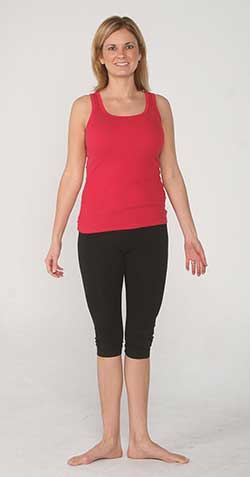
Duck Stand
The gluteus maximus muscle works concentrically to extend the hips and externally rotate the leg. It works eccentrically to slow down hip flexion, internal rotation of the leg and subsequent pronation of the foot. Strengthening the gluteus maximus muscle with this isometric, concentric exercise will help prepare it for the more dynamic eccentric strengthening exercise, Lunge With Knee Pull (shown below), to help decrease overpronation (Price, 2010).
Stand with the heels together and feet turned out like a duck. Tuck the pelvis under (i.e., posteriorly rotate) and gently try to rotate the legs outward without moving the feet. As the legs rotate outward, the gluteus maximus muscle on both sides should contract, causing the ankles to roll out slightly and the arches of the feet to raise. Hold this contracted position for three to five seconds, relax and repeat eight to 10 times once per day.
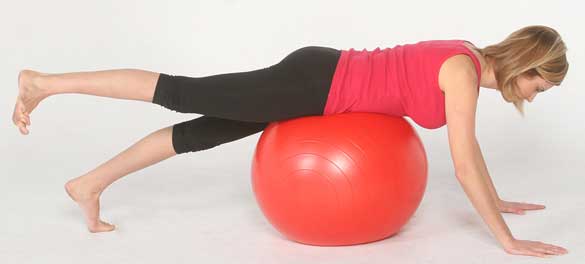
Leg Lift
Once your client can control activation of the gluteus maximus muscle, progress to this more complex movement. It involves both concentric (i.e., lifting the leg) and eccentric (i.e., lowering the leg) contraction of the gluteus maximus muscle while stabilizing the lumbar spine.
Lie over a stability ball and balance the body with the hands on the ground. Use the muscles of the right gluteal complex to lift the right leg off the ground without arching the lower back. Once your client can lift the leg without arching the lower back, progress by turning the right leg outward and/or inward on subsequent repetitions to activate different fibers of the glutes. Perform 10 to 12 repetitions on each side once per day.
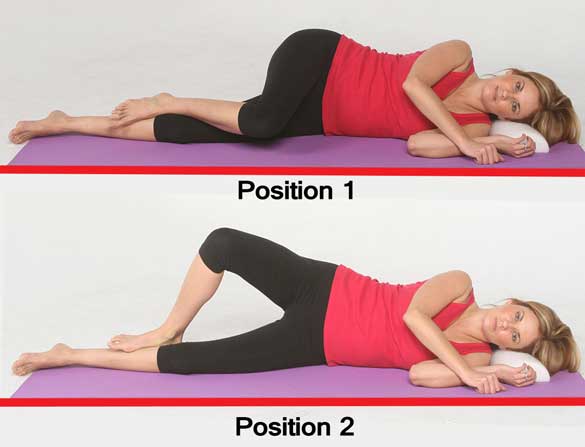
Side-lying Leg Lift
The gluteus minimus and gluteus medius muscles act eccentrically to slow down the leg as it travels toward the midline of the body across the foot and ankle. When these muscles are weak and not functioning correctly, the leg collapses, causing the foot to overpronate. Strengthening these muscles helps decrease the effects of overpronation (Price, 2010).
Lie on the left side of the body with the head supported. Bend the right knee and position the instep of the right foot on the inside of the left knee. Posteriorly rotate the pelvis (i.e., tuck it under) and gently lift the right knee without arching the lower back or rotating the hips. Perform this exercise slowly, allowing plenty of time for the nervous system to connect kinesthetically to the muscles on the sides of the hips and buttocks. Progress this exercise by slowing down the lowering of the leg so that the eccentric portion of this exercise takes twice as long as the lifting (e.g., concentric) phase. Perform 10 to 12 repetitions on each side, once a day.
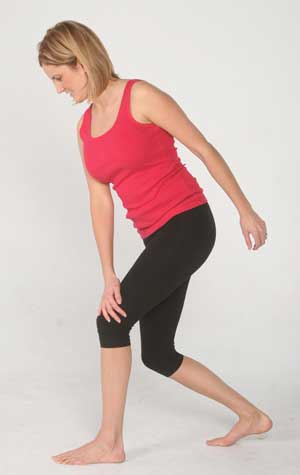
Lunge With Knee Pull
This exercise combines isometric, concentric and eccentric movements, and is designed to strengthen the muscles of the foot, ankle, lower leg, quadriceps, gluteal complex, abdominals and spine to retrain the entire kinetic chain and decrease overpronation.
Stand in a staggered lunge position with the left foot forward. Bend at the hips (without rounding the spine), rotate the torso and grab the outside of the left knee with the right hand. Slowly bend the knees and lunge gently while pulling the left knee toward the midline of the body. As the left knee pulls inward, rotate the left shoulder backward so the spine and rib cage turn behind the left hip. As the weight is transferred forward into the left leg, push the left big toe down into the ground (as described in the Big Toe Pushdown exercise) to help stabilize the foot and ankle. The client should feel all the muscles in the left gluteal complex contract as they work to steady the pelvis, spine, hips and leg. Return to the starting position and repeat six to 10 repetitions on each side for one to two sets at least three times per week.
Conclusion
Designing corrective exercise programs that successfully alleviate muscle and joint pain is a rewarding experience for both you and your clients. Using strategic musculoskeletal assessments and applying your knowledge of SMR techniques, stretching and corrective strengthening exercises enables you to address the underlying causes of a client’s pain or dysfunction to eliminate movement issues so clients can participate safely in regular fitness programs.
Become a BioMechanics Method® Corrective Exercise Specialist

Want to learn more about how you can help your clients exercise with less pain? The BioMechanics Method® Corrective Exercise Specialist online course (TBMM-CES) is specifically designed to give fitness professionals a step-by-step process for helping clients overcome muscle and joint pain. Created by Justin Price, one of the top musculoskeletal assessment and corrective exercise experts in the world, this course will give you the postural assessment, anatomy, corrective exercise and program design skills necessary to help clients become pain free. This self-paced study course is valued at 8.0 ACE CECs and includes digital textbooks, videos and online quizzes.
References
American Council on Exercise (2014). ACE Personal Trainer Manual (5th ed.). San Diego, Calif.: American Council on Exercise.
Gray, H. (1995). Gray’s Anatomy. New York: Barnes & Noble Books.
Kemmler, W. et al. (2004). Benefits of two years of intense exercise on bone density, physical fitness and blood lipids in early postmenopausal osteopenic women. Archives of Internal Medicine, 164, 10, 1084-1091.
Kendall, F.P. et al. (2005). Muscles Testing and Function with Posture and Pain (5th ed.). Baltimore, Md.: Lippincott Williams & Wilkins.
Kim, H.D. and Park, J.S. (2006). The effect of an exercise program on body composition and physical fitness in obese female college students. Journal of Korean Academy of Nursing, 36, 1, 514.
Kisner, C. and Colby, L.A. (1990). Therapeutic Exercise: Foundations and Techniques (2nd ed.). Philadelphia: F.A. Davis Company.
Ornish, D. (1996). Dr. Dean Ornish’s Program for Reversing Heart Disease. New York: Random House.
Peters, H.P. et al. (2001). Potential benefits and hazards of physical activity and exercise on the gastrointestinal tract. Gut, 48, 3, 435-439.
Price, J. (2013). The Amazing Tennis Ball Back Pain Cure. The BioMechanics Press.
Price, J. (2010). The BioMechanics Method Corrective Exercise Educational Program. The BioMechanics Press.





 by
by 








